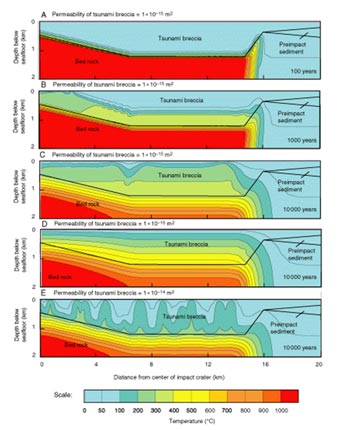HYDROTHERM
A Computer Code for Simulation of Two-Phase Ground-Water Flow and Heat Transport in the Temperature Range of 0 to 1200 Degrees Celsius
The HYDROTHERM computer program simulates multi-phase ground-water flow and associated thermal energy transport in three dimensions. It can handle high fluid pressures, up to 1 x 109 Pa (104 atm), and high temperatures, up to 1,200 °C. This report documents the release of Version 3, which includes various additions, modifications, and corrections that have been made to the original simulator. Major changes to the simulator include: 1) the ability to simulate unconfined ground-water flow, 2) a precipitation-recharge boundary condition, 3) a seepage-surface boundary condition at the land surface, 4) the removal of the limitation that a specified-pressure boundary also have a specified temperature, 5) a new iterative solver for the linear equations based on a generalized minimum-residual method, 6) the ability to use time- or depth-dependent functions for permeability, 7) the conversion of the program code to Fortran 90 to employ dynamic allocation of arrays, and 8) the incorporation of a graphical user interface (GUI) for input and output.
The graphical user interface has been developed for defining a simulation, running the HYDROTHERM simulator interactively, and displaying the results. The combination of the GUI and the HYDROTHERM simulator forms the HYDROTHERM INTERACTIVE (HTI) program. HTI can be used for two-dimensional simulations only. HYDROTHERM originated as a standalone program that reads model specification data from input files, and writes simulation results to output files. The HYDROTHERM INTERACTIVE GUI software integrates HYDROTHERM 3 with a graphical-user-interface preprocessor and postprocessor so that simulations can be setup and run in a visual-interactive environment.
New features in Version 3 of the HYDROTHERM simulator have been verified using four test problems. Three problems come from the published literature and one problem was simulated by another partially saturated flow and thermal transport simulator. The test problems include: transient partially-saturated vertical infiltration, transient one-dimensional horizontal infiltration, two-dimensional steady-state drainage with a seepage surface, and two-dimensional drainage with coupled heat transport.
An example application to a hypothetical stratovolcano system with unconfined ground-water flow is presented in detail. It illustrates the use of HTI with the combination precipitation-recharge and seepage-surface boundary condition, and functions as a tutorial example problem for the new user.
ht_wdh is a specialized extension of version 3 of HYDROTHERM. This extended version implements the dynamic-permeability model of Weis and others (2012, Science, v. 338, p. 1613-1616). Version 3.2.0 remains the default for applications that do not require this capability.
Disclaimer Statements
Although this program has been used by the USGS, NO WARRANTY, expressed or implied, is made by the USGS or the United States Government as to the accuracy and functioning of the program and related program material nor shall the fact of distribution constitute any such warranty, and no responsibility is assumed by the USGS in connection therewith.
Please note that some U.S. Geological Survey (USGS) information accessed through this page may be preliminary in nature and presented prior to final review and approval by the Director of the USGS. This information is provided with the understanding that it is not guaranteed to be correct or complete and conclusions drawn from such information are the sole responsibility of the user.
Any references to commercial vendors of software products or services are provided solely for the convenience of users when obtaining or using USGS software. Such references do not imply any endorsement by the U.S. Government.
Adobe Acrobat Reader can be used to view pdf files.

